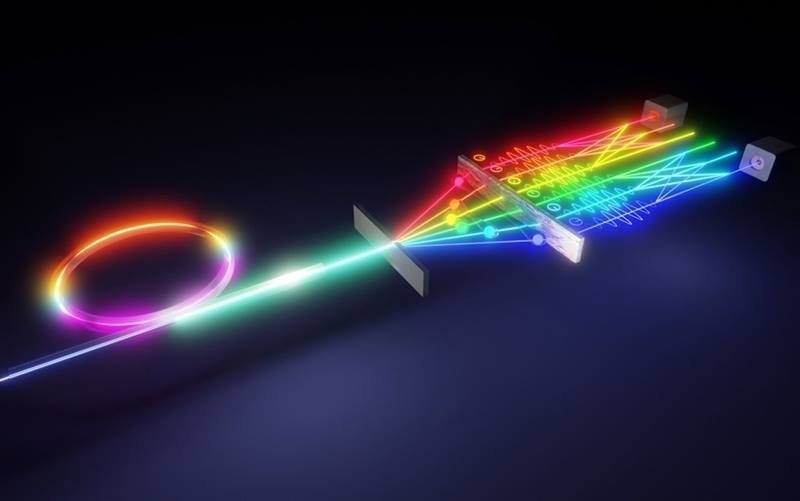Data is exclusively classified using ones or zeros in classical computer bits. Qubits, or quantum bits, on the other hand, could simultaneously hold values of one and zero. Qudits, lesser-known relatives of qubits, provide several benefits. They can carry more information and are more resistant to the noise that can cause qubits to lose information.

The microring resonator, shown here as a closed loop, generated photon pairs. Researchers examined these photons by manipulating the phases of different frequencies, or colors, of light and mixing frequencies, shown by the crisscrossed multicolor lines. Image Credit: Oak Ridge National Laboratory
Qudits, however, have historically been challenging for scientists to quantify and alter. Researchers have now created a way to more precisely measure qudits encoded in light sources to overcome this problem.
The Impact
Leveraging the potential of qudits would help to enhance the performance of numerous quantum technologies. Among these are quantum networks, utilizing photons, the fundamental units of light, to facilitate the exchange of information across extensive spans.
Additionally, quantum key distribution systems employ quantum mechanical principles to transmit data through cryptographic "locks" and "keys." Looking to the future, qudits could play an important role in the creation of a possible quantum internet that could distribute quantum information on a large scale.
Summary
A microring resonator was used in the experiment by a group of scientists from Oak Ridge National Laboratory (ORNL), Purdue University, King Saud University, the Swiss Federal Institute of Technology, and Torch Technologies to create frequency-bin pairs. These two quantum objects are entangled in their frequency as photons.
Entanglement refers to a pair of particles that are intrinsically connected regardless of the physical distance between them. Instead of being reliant upon a quantum gate, a type of quantum circuit often used in quantum computing research, the team decided to use an electro-optic phase modulator, which mixes various light frequencies, and a pulse shaper, which can modify the timing of those frequencies.
Following the success of these operations, the team managed to capture a significant number of different frequency correlations.
The researchers then developed a data analysis tool based on a statistical method called Bayesian inference and ran simulations on ORNL computing resources to work backward and infer which quantum states produced the measured frequency correlations. This technology could enable thorough experiments of entanglement switching, which involves purposefully entwining two previously unrelated particles, as well as teleportation, a way of conveying quantum information, in combination with current fiber-optic networks.
The National Science Foundation, the Air Force Office of Scientific Research, the Department of Energy Office of Science, the Advanced Scientific Computing Research Program, and the Swiss National Science Foundation provided funding for this study.
Journal Reference:
Ortkrass, H., et al. (2023) Bayesian tomography of high-dimensional on-chip biphoton frequency combs with randomized measurements. Nature Communications. doi:10.1038/s41467-022-31639-z